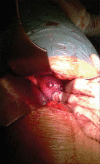Usage of invisible near infrared light (NIR) fluorescence with indocyanine green (ICG) and methylene blue (MB) in urological oncology. Part 1
- PMID: 25140227
- PMCID: PMC4132597
- DOI: 10.5173/ceju.2014.02.art5
Usage of invisible near infrared light (NIR) fluorescence with indocyanine green (ICG) and methylene blue (MB) in urological oncology. Part 1
Abstract
Introduction: Near infrared (NIR) technology has recently garnered much interest as a tool for intraoperative image-guided surgery in various surgical sub-disciplines. In urology, although nascent, NIR technology is also fostering much enthusiasm. This review discusses the two major fluorophores, indocyanine green (ICG) and methlyene blue (MB), with NIR guidance in experimental and clinical urology. The authors aim to illustrate and analyze the currently available initial studies to better understand the potential and practicability of NIR-guided imaging in the diagnosis and surgical outcome improvement. In the first part of the study we analyzed problems associated with sentinel lymph node biopsy, NIR-guided detection and imaging of tumors.
Material and methods: PubMed and Medline databases were searched for ICG and MB use in urological settings, along with data published in abstracts of urological conferences.
Results: Although NIR-guided ICG and MB are still in their initial phases, there have been significant developments in major domains of urology, including uro-oncological surgery: 1) sentinel lymph node biopsy, 2) detection and imaging of tumors.
Conclusions: Much like in other fields of surgical medicine, the application of NIR technology in urology is at its early stages. Therefore, more studies are needed to assess the true potential and limitations of the technology. However, initial developments hint towards a pioneering tool that may influence various aspects of urology.
Keywords: indocyanine green; methylene blue; near infrared fluorescence; sentinel node.
Figures









References
-
- Krajka K, Tatarkiewicz–Suchorzewska J. Przydatność próby z zielenią indocyaninową w rozpoznaniu chorób wątroby [Usefulness of tests with Indocyanine green in the diagnosis of liver disease] Pol Przegl Chir. 1971;43:11. - PubMed
-
- Krajka K, Kopacz A. Effect of decompression of billiary tract on the course of elimination curve of indocyanine green from the blood. Przegl Lek. 1973;30:5. - PubMed
-
- Polom K, Murawa D, Rho YS, Nowaczyk P, Hünerbein M, Murawa P. Current trends and emerging future of indocyanine green usage in surgery and oncology. Cancer. 2011;117:4812–4822. - PubMed
Publication types
LinkOut - more resources
Full Text Sources
Other Literature Sources
Miscellaneous
